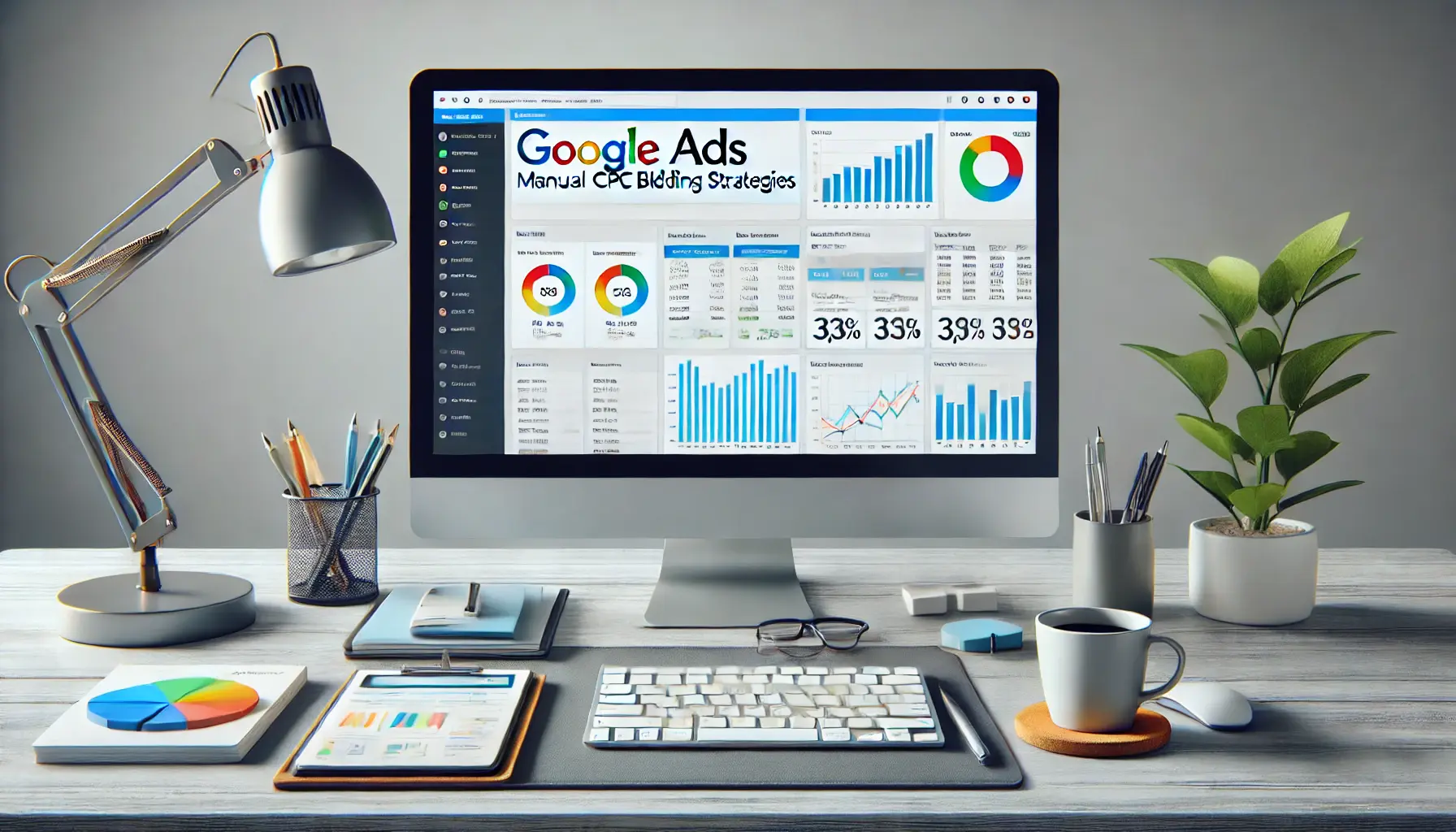In today’s competitive digital landscape, mastering the art of bid management within Google Ads is integral to every marketer’s desire to squeeze maximum value from each advertising dollar.
Whether it’s conversions, clicks, or brand visibility, knowing how to efficiently handle bid management separates success from waste in your marketing budget.
With the different ways you can bid, it’s essential to learn how to strategically approach bid management so that every dollar spent adds value to your business.
The aim of this article is to take you through some of the most effective bid management strategies in Google Ads, starting with the basics and advancing to more complex techniques that ensure maximum return on investment (ROIReturn on Investment, a performance measure used to evaluate the efficiency or profitability of an investment.).
By the end, you’ll have a clearer understanding of how to tailor your bid management strategy to align with your campaign goals, ensuring that your ads are reaching the right people at the right time.
- Introduction to Bid Management in Google Ads
- Pragmatic Key Bid Management Strategies for Optimal Results
- Advanced Bid Adjustments for Specific Goals
- Bid Optimization Tools and Best Practices
- Measuring Success and Optimizing Bid Strategies
- Mastering Bid Management Strategies to Yield Optimal Results
- Frequently Asked Questions About Bid Management in Google Ads
Introduction to Bid Management in Google Ads
Bid management is the backbone of any Google Ads campaign.
It’s not just about setting the maximum bid for your ads; it’s about optimizing your bids to meet specific advertising goals.
Whether you’re running traffic, lead generation, or sales-generating campaigns, your bid management approach plays a significant role in the performance of your campaigns.
Understanding the role of bid management in Google Ads is essential for any marketer.
It affects how much you pay for each click or impression, while also influencing the placement and frequency of your ads.
Bid management involves both manual and automated strategies, each with its own advantages, depending on what best fits your campaign’s needs and objectives.
In this section, we will cover the basics of bid management, setting the stage for more advanced strategies to follow.

Illustration of bid management in digital advertising.
What is Bid Management?
Bid management refers to controlling the price an advertiser is willing to pay each time someone clicks an ad or views an ad in a Google Ads auction.
It’s a dynamic process that requires constant monitoring to ensure you’re maximizing the value of your ad spend.
The goal of bid management is to establish an optimal bidding strategy where you pay the minimum necessary to achieve your desired outcomes, such as conversions or clicks.
Bid management is not a one-size-fits-all approach.
Depending on your campaign goals and budget, you can opt for manual bidding, where you control the bids at the keyword level, or automated bidding, where Google’s algorithms automatically adjust bids based on factors such as user behavior, device type, and time of day.
Understanding the strengths and limitations of each approach is crucial for successful bid management.

Illustration of the significance of bid management in ad campaigns.
The Importance of Bid Management in Ad Campaigns
Good bid management can make or break your Google Ads campaign.
When implemented effectively, it ensures that your ads are shown to the right audience at the right time without overspending.
Poor bid management, on the other hand, can lead to a wasted budget, low ad visibility, and missed opportunities.
Continuous optimization of your bids improves campaign performance, increases ad rank, and drives more conversions or sales.
One of the key advantages of effective bid management is cost control while maximizing value.
With both manual and automated strategies, you can be confident you’re paying no more than necessary to achieve your advertising goals.
Moreover, bid management helps you stay competitive in the ad auction, where higher bids don’t always guarantee better placements—smart bidding strategies often lead to better results.
Effective bid management directly influences the success of your Google Ads campaigns by optimizing your ad spend for desired outcomes such as clicks or conversions.

Illustration of key bid management strategies for optimal results.
Pragmatic Key Bid Management Strategies for Optimal Results
Effectively managing the bidding process is an art of selecting the right strategy to meet your campaign goals.
Whether your goal is conversions, traffic, or brand awareness, the right bid management strategy will make all the difference in your ad’s performance and return on investment.
In Google Ads, a variety of bid management strategies are available to fit a range of objectives, from full manual control to fully automated bidding options.
Let’s break down some of the key strategies that can help you optimize performance in your Google Ads campaigns:
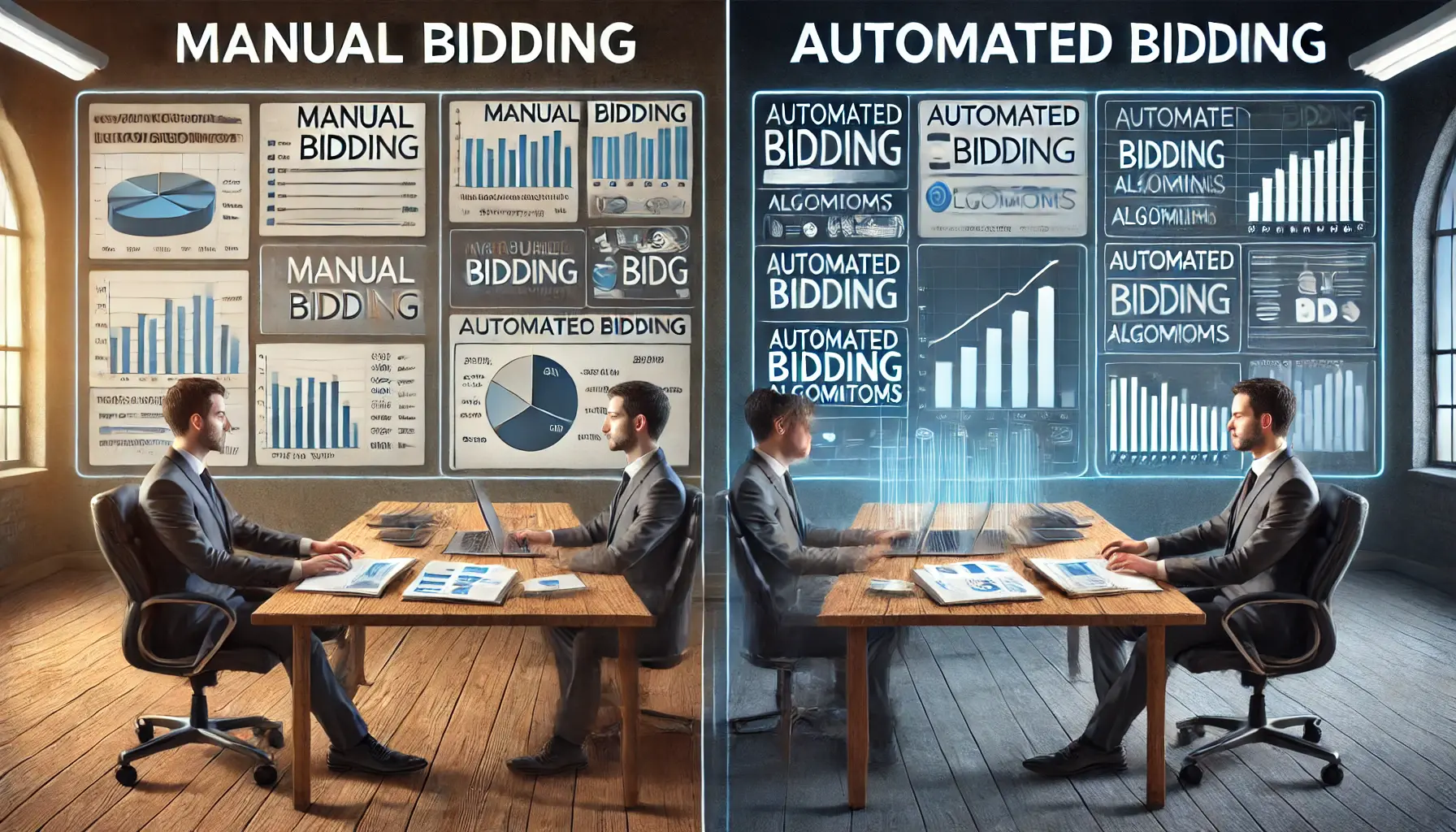
Illustration comparing manual and automated bidding strategies.
Manual Bidding vs. Automated Bidding
One of the first decisions a marketer needs to make when managing bids is choosing between manual bidding and automated bidding.
Manual bidding allows you to have complete control over the bids for every keyword or ad placement.
This strategy works well when you want to prioritize specific terms or ad groups, but it requires constant monitoring and adjustments.
On the other hand, automated bidding relies on Google’s algorithms, which automatically adjust bids in real-time based on factors like user behavior, device, time of day, and competition.
Automated bidding saves time by leveraging machine learning models to continuously optimize bids.
Google offers several automated bidding strategies, each designed for different campaign goals.

Illustration of the Target CPA strategy in digital advertising.
Target CPA (Cost-Per-Acquisition) Strategy
Target CPACost Per Acquisition, a metric that measures the aggregate cost to acquire one paying customer on a campaign. is a well-known automated bidding strategy.
It allows you to set a target cost per acquisition, and Google adjusts your bids to help you achieve that goal.
This strategy is especially effective for campaigns focused on generating leads or sales, as it helps prevent overspending on conversions.
- Pros: Allows you to control your cost per conversion, making it ideal for driving consistent results.
- Cons: May limit your reach if the target CPA is set too low.

Illustration of the Target ROAS strategy in digital advertising.
Target ROAS (Return on Ad Spend) Strategy
For businesses aiming to maximize revenue, the Target ROASReturn on Ad Spend, a marketing metric that measures the revenue generated for every dollar spent on advertising. strategy can be very effective.
It enables you to set a target return on ad spend, and Google adjusts your bids to meet that target.
This strategy is ideal for eCommerce campaigns, where the goal is to generate a specific return based on your ad spend.
- Pros: Maximizes revenue by focusing on high-value conversions.
- Cons: Requires sufficient historical data to predict accurate outcomes.

Illustration of maximizing clicks and impression share in digital advertising.
Maximizing Clicks and Impression Share
If your campaign’s primary goal is to drive traffic or increase brand visibility, strategies like Maximizing ClicksA bidding strategy that aims to get the most clicks for your budget. or Impression ShareThe percentage of total impressions that your ad receives compared to the total available impressions. are ideal.
Maximizing Clicks automatically adjusts bids to get the most clicks possible within your budget.
Impression Share bidding focuses on ensuring that your ads appear in a certain percentage of eligible impressions, either at the top of the page or anywhere on the page.
- Maximizing Clicks: Best for driving traffic to your website.
- Impression Share: Ideal for brand awareness and ensuring your ads appear in front of your target audience.
Choosing the right bid strategy—manual or automated—will significantly impact the success and efficiency of your ad campaigns.

Illustration of advanced bid adjustments for specific goals in digital advertising.
Advanced Bid Adjustments for Specific Goals
While selecting the right bid management strategy is crucial, advanced bid adjustments are ways to further optimize your campaigns for specific goals.
Google Ads allows advertisers to make more granular adjustments to their bids based on factors such as device type, time of day, location, and audience segments.
These bid adjustments help optimize ad performance by allocating more budget where it matters most and making fine-tuned adjustments to align with user behavior and campaign goals.
Let’s discuss several advanced bid adjustments you can make to optimize the performance of your Google Ads campaigns:

Illustration of device-level bid adjustments in digital advertising.
Device-Level Bid Adjustments
Device-level bid adjustments allow you to control how much you would like to bid depending on whether users are on mobile, desktop, or tablet devices.
This is especially useful for businesses where performance varies based on the device.
For example, if mobile traffic tends to convert better than desktop traffic, you can increase your bids for mobile users.
Conversely, if certain devices show lower conversion rates, you can reduce bids accordingly.
- Tip: Analyze your performance data regularly to identify which devices are delivering the highest return and adjust your bids accordingly.

Illustration of time of day and location-based bids in digital advertising.
Time of Day and Location-Based Bids
Another key adjustment available in Google Ads is the ability to modify your bids based on the time of day or geographic location.
If you know that your target audience is more likely to click on your ads during specific hours or in certain regions, you can increase bids during those high-traffic times or places.
This ensures your ads are more visible when potential customers are most active.
- Time of Day: Adjust bids to capture peak activity hours, such as lunch breaks or evenings when engagement is most likely.
- Location-Based Bidding: Increase bids for regions or cities where demand for your business is high or has a larger prospect pool.

Illustration of audience segmentation and bid customization in digital advertising.
Audience Segmentation and Bid Customization
Audience bid adjustments allow you to modify bids according to specific audience segments.
Using first-party data, Google Ads enables you to bid higher on audiences that are more valuable to your business, such as returning visitors, customers who have made previous purchases, or users on your email list.
This tactic helps prioritize high-intent users and can significantly boost conversions and revenue.
- Tip: Create detailed audience lists and monitor their performance to identify which segments deliver the most conversions.

Illustration of seasonal and event-based bidding strategies in digital advertising.
Seasonal and Event-Based Bidding Strategies
Seasonality and events can have a significant impact on consumer behavior.
With Google Ads, you can adjust bids during key seasons or around major events relevant to your industry.
For example, eCommerce companies often increase bids during the holiday season, while travel companies may increase bids before major holidays when demand for travel rises.
Event-based bidding ensures that your ads remain competitive when consumer activity spikes.
- Tip: Plan ahead and develop custom bid adjustments around seasonal events like Black Friday, or industry-specific events such as conferences or product launches.
Advanced bid adjustments, such as device, time, and audience-based adjustments, offer granular control over ad performance and budget allocation.

Illustration of bid optimization tools and best practices in digital advertising.
Bid Optimization Tools and Best Practices
The right strategy, along with tools and best practices, is crucial for successful bid management in Google Ads.
Google provides several built-in tools that help advertisers manage their bids effectively.
Additionally, third-party solutions complement these tools by offering deeper insights and allowing you to make more educated decisions.
In this section, we’ll cover some of the essential tools and best practices to help you optimize your bids.

Illustration of using the Google Ads Bid Simulator in digital advertising.
Using Google Ads Bid Simulator
The Google Ads Bid SimulatorA Google Ads tool that estimates how different bid amounts could affect your ad's performance. is an invaluable tool for advertisers looking to understand how different bid amounts could impact their ad performance.
This tool provides insights into what would have happened if you had set higher or lower bids during a specific period.
By analyzing this data, you can make more informed decisions about when to increase or decrease your bids.
- Tip: Use the Bid Simulator to explore different bid levels and see their potential impact on clicks and conversions without overspending on your campaigns.

Illustration of incorporating third-party bid management tools in digital advertising.
Incorporating Third-Party Bid Management Tools
While Google Ads offers powerful bid management features, third-party tools can enhance your campaigns even further.
These tools provide advanced automation, AI-powered recommendations, and enhanced reporting capabilities.
Platforms like WordStream, Optmyzr, and Kenshoo are commonly used by marketers to simplify bid management and optimize campaigns more effectively.
Third-party integrations are especially useful for larger campaigns requiring more granular bid optimization than Google Ads alone may offer.

Illustration of leveraging data insights for bid refinement in digital advertising.
Leveraging Data Insights for Bid Refinement
To maximize your bid management efforts, it’s important to constantly review key performance indicators (KPIs) like conversion rates, click-through rates (CTRClick-Through Rate, the ratio of users who click on an ad compared to the total number of users who view it.), and cost-per-acquisition (CPA).
This allows you to dynamically adjust your bids to achieve the best performance without exceeding your budget.
- Tip: Schedule regular performance reviews to gain insights into how your bids impact key metrics and make necessary adjustments for improved results.
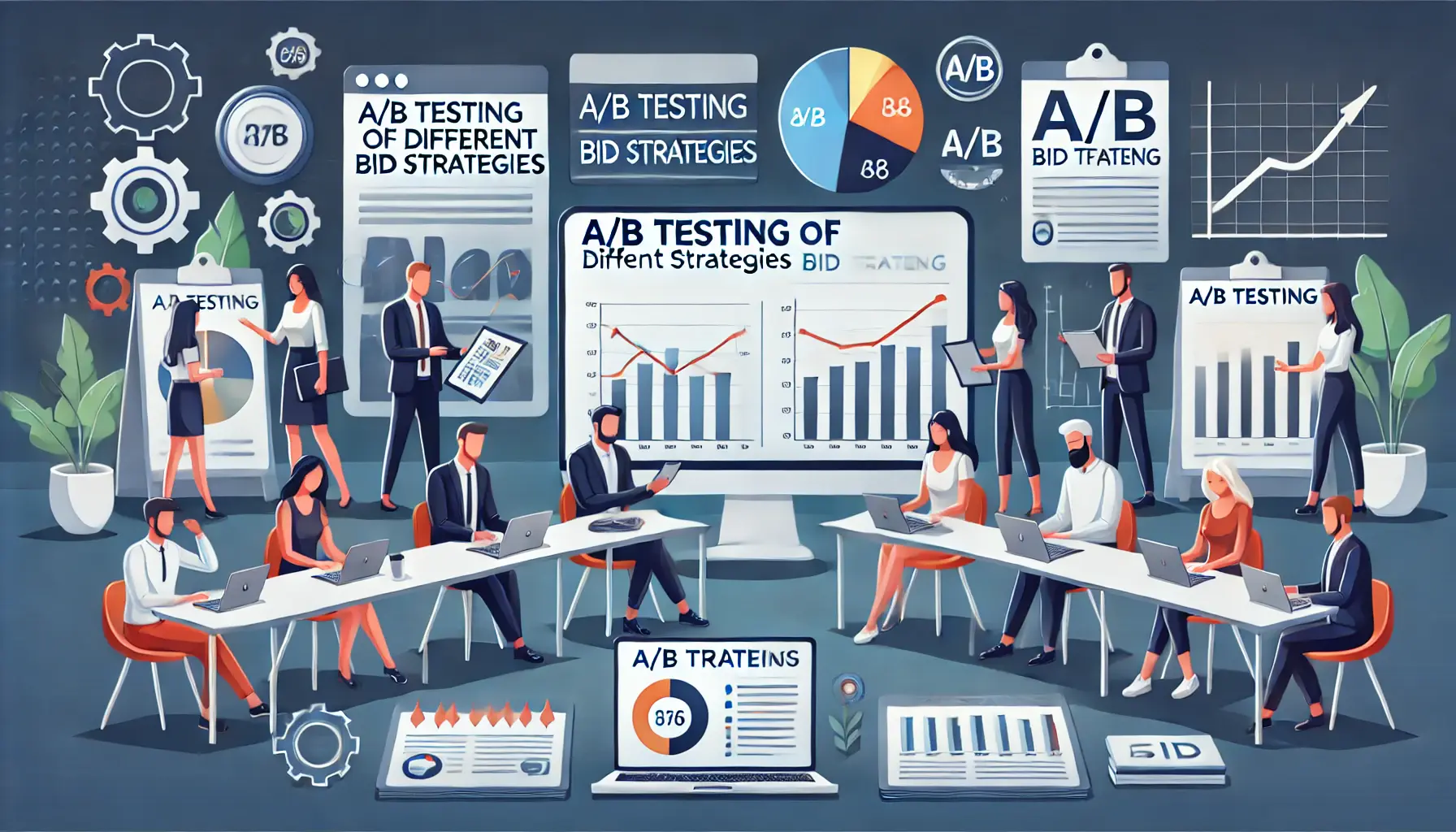
Illustration of A/B testing different bid strategies in digital advertising.
A/B Testing Different Bid Strategies
A/B testing is a powerful method for comparing different bid strategies.
By running tests with two or more variants of bid settings, you can determine which works best for your campaign goals.
This approach helps you refine your bids and ensures that you’re using the most effective bidding strategy for your specific objectives.
- Tip: Regularly run A/B tests on your bid strategies to optimize performance and find the ideal approach for each campaign type.
Using tools like the Google Ads Bid Simulator and third-party platforms ensures better bid management and campaign optimization.

Illustration of measuring success and optimizing bid strategies in digital advertising.
Measuring Success and Optimizing Bid Strategies
Once you have implemented your bid management strategy into Google Ads, it is essential to monitor its success and refine your bid strategies.
Regularly checking on your bids ensures that you remain competitive, optimize performance, and maximize return on investment (ROI).
In this section, we will discuss key performance indicators (KPIs) to track, how to know when it’s time to adjust your bid strategy, and best practices for tracking ROI and bid efficiency.

Illustration of key performance indicators analysis in digital advertising.
Key Performance Indicators Analysis
The foundation of understanding how well or poorly your bidding strategies are performing lies in tracking KPIs.
The most important KPIs to focus on include:
- Conversion Rate: The percentage of clicks that lead to a desired action, such as a purchase or signup. A high conversion rate indicates that your bid strategy is targeting the right audience.
- Click-Through Rate (CTR): The ratio of people who click on your ad compared to how many people view the ad. A low CTR could indicate that your bids are too low, or that the ad copy is unappealing.
- Cost-Per-Acquisition (CPA): Tracks how much is spent by an advertiser to generate a conversion. Monitoring CPA ensures you are not overspending to achieve your conversions.
- Return on Ad Spend (ROAS): Measures the revenue generated for every dollar of ad spend. A high ROAS indicates strong returns and that your bids are well-optimized.

Illustration of when and how to adjust your bid strategy in digital advertising.
When and How to Adjust Your Bid Strategy
The need to adjust your bid strategy arises when KPIs indicate underperformance or when your business goals change.
Common scenarios that require bid adjustments include:
- Underperforming KPIs: If you observe a decline in CTR, conversion rate, or ROAS, it may be time to re-evaluate your bid strategy. Increase bids for high-performing keywords or reduce bids for those that aren’t delivering the desired results.
- Budget Changes: When your advertising budget increases or decreases, adjust your bids accordingly. A larger budget allows for more aggressive bids, while a smaller budget requires more conservative bidding.
- Seasonality and Trends: Align your bids with seasonal trends, special events, or market fluctuations that could impact ad performance.
Illustration of tracking ROI and improving bid efficiency in digital advertising.
Tracking ROI and Improving Bid Efficiency
Tracking ROI is crucial to understanding the effectiveness of your bid management strategy.
Best practices for improving bid efficiency and ROI include:
- Set Clear Goals: Define specific, measurable goals for each campaign, such as increasing sales by 20% or reducing CPA by 15%.
- Regular Performance Reviews: Schedule regular reviews of your campaign performance to ensure that your bids are aligned with your goals.
- Leverage Automation: Use Google Ads’ automated bid strategies to optimize for conversions, clicks, or ROAS. Automation helps maintain optimized bids without requiring constant manual adjustments.
- Test and Iterate: Continuously test new bid strategies and optimize based on performance data. A/B testing and performance reviews will help refine your approach over time.

Illustration of common mistakes in bid management and strategies to avoid them.
Common Mistakes in Bid Management and How to Avoid Them
Even experienced marketers can make mistakes when managing bids.
Here are some common bid management pitfalls and tips to avoid them:
- Overbidding or Underbidding: Setting bids too high can lead to overspending, while bidding too low may hurt ad visibility. Maintain a balanced approach by regularly monitoring performance.
- Ignoring Data: Failing to analyze data and metrics can result in missed optimization opportunities. Use data-driven insights to guide your bid management decisions.
- Setting and Forgetting Bids: Bid management is dynamic and requires continuous adjustments. Avoid setting your bids and leaving them unchanged for extended periods.
Tracking KPIs and adjusting bids based on real-time data ensures ongoing optimization and improved return on investment.
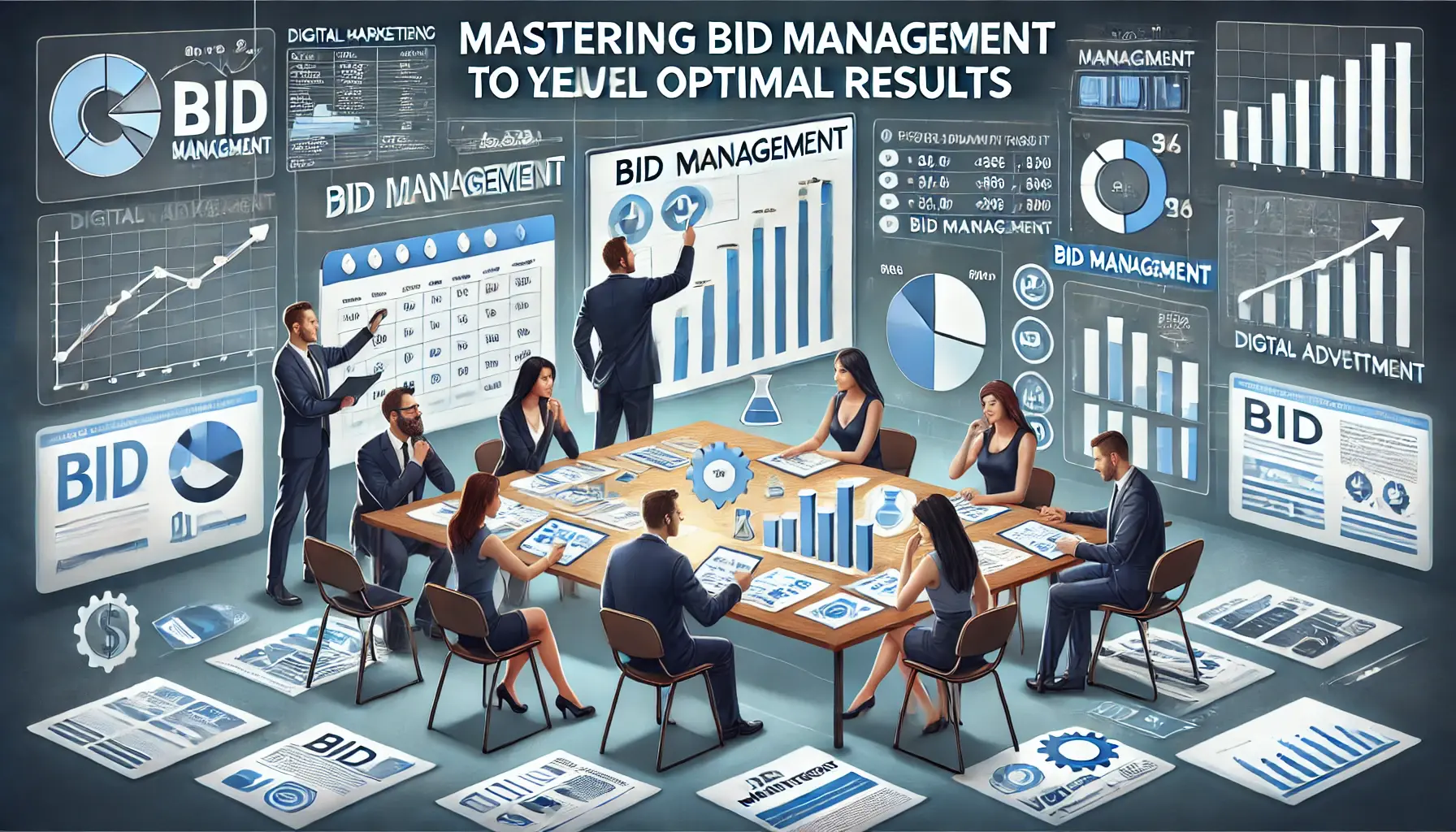
Illustration of mastering bid management strategies for optimal results in digital advertising.
Mastering Bid Management Strategies to Yield Optimal Results
In the fast-paced world of digital advertising, mastering bid management strategies in Google Ads is essential for your brand’s success.
The right combination of strategy, tools, and optimization practices can significantly impact the performance of your campaigns and overall return on investment (ROI).
Throughout this article, we explored key strategies and practices that can enhance a well-managed bid for an optimized outcome.

Illustration of a recap of key bid management strategies in digital advertising.
Recap of Key Bid Management Strategies
Bid management in Google Ads involves selecting the appropriate approach to accomplish your campaign goals, whether they are focused on conversions, traffic, or brand awareness.
By knowing when to use manual bidding versus automated bidding, and by leveraging strategies like Target CPAA bidding strategy in Google Ads that sets bids to help you get as many conversions as possible at the target cost per acquisition. and Target ROAS, you can optimize your campaigns to achieve key objectives.
Some of the more nuanced bid adjustments we discussed included:
- Device-Level Bid Adjustments
- Time of Day and Location-Based Bids
- Audience Segmentation and Bid Customization
- Seasonal and Event-Based Bidding
These adjustments allow for greater granularity with your bids, helping you allocate budget and resources where they will have the most impact.

Illustration of tools and best practices for optimizing bid strategies in digital advertising.
Tools and Best Practices to Optimize Bid Strategies
Using the right tools and following best practices are crucial for successful bid management.
The Google Ads Bid Simulator, third-party tools like WordStream and Optmyzr, and data-driven insights all contribute to better decision-making in bid optimization.
Regular performance reviews and A/B testingA method of comparing two versions of a web page or ad to determine which one performs better. are also important for refining your strategy over time.
Illustration of tracking KPIs and making bid adjustments in digital advertising.
Tracking KPIs and Adjusting Bids
Monitoring and tracking key performance indicators (KPIs) such as conversion rate, click-through rate (CTR), cost-per-acquisition (CPA), and return on ad spend (ROAS) ensures that you continuously adjust bids to stay competitive and optimize performance.
Changes in business goals, budget allocations, and market conditions should also be reflected in your bid management approach.
Being responsive to seasonal trends and traffic spikes can help you capitalize on opportunities while avoiding potential risks.

Illustration of key takeaways for successful bid management in digital advertising.
Key Takeaways for Successful Bid Management
Here are the key takeaways for successful bid management in Google Ads:
- Choose the Right Bidding Strategy: Depending on your campaign goals, select the appropriate bidding strategy between manual or automated bidding.
- Fine-Tune Your Bids: Use advanced bid adjustments to optimize bids based on device, time, location, and audience.
- Optimize Bids with Tools: Leverage tools like Google Ads Bid Simulator and third-party platforms for efficient bid optimization.
- Track KPIs Consistently: Regularly track KPIs and update your bids based on real-time data to drive improved ROI.
- Avoid Common Pitfalls: Avoid overbidding, underbidding, and other common mistakes by following best practices and conducting routine performance reviews.

Illustration of final thoughts in digital advertising strategy.
Final Words
Mastering Google Ads bid management strategies is an ongoing process that requires continuous learning, testing, and adaptation.
By implementing the strategies and tools discussed in this article, you will be better equipped to navigate the complexities of Google Ads and ensure meaningful results in your campaigns.
Whether your focus is on conversions, traffic, or brand visibility, effective bid management will lead to improved ad performance and a higher return on your advertising investment.
Mastering bid management strategies ensures your ads are optimized for performance, driving maximum ROI and campaign success.
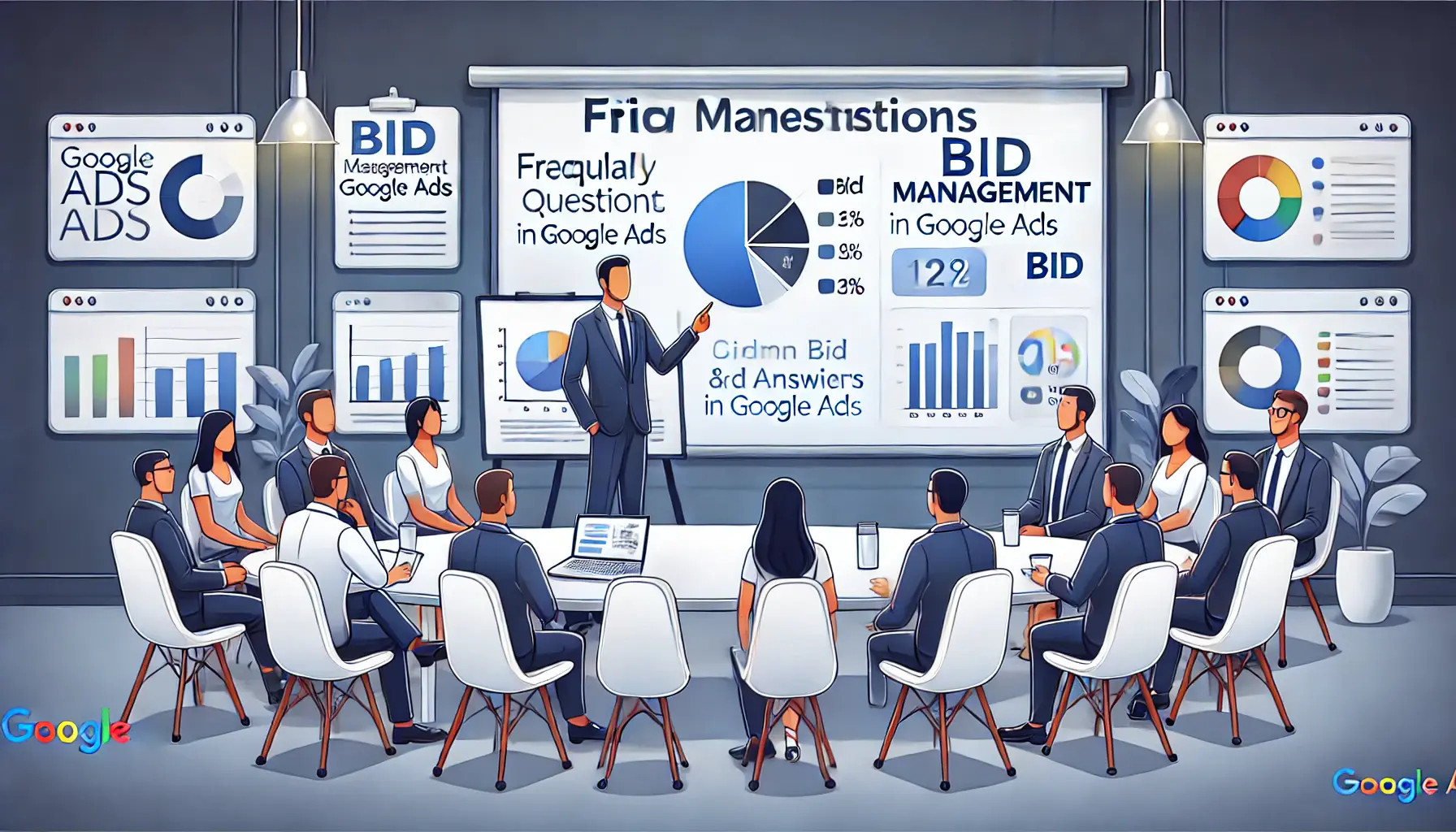
Illustration of frequently asked questions regarding bid management in Google Ads.
Your campaigns can be managed by an agency specialized in Google Ads, check out our service page.
Frequently Asked Questions About Bid Management in Google Ads
Below, we have included frequently asked questions about bid management strategies in Google Ads.
These questions cover key aspects that will help you understand the topic better and elevate your campaigns to the next level.
Bid management allows you to control your cost per click or impression in Google Ads to achieve your campaign goals, whether it is conversions, traffic, or brand awareness.
Manual bidding gives advertisers full control over their bids, while automated bidding leverages Google’s algorithms to adjust bids in real-time to meet specific goals such as conversions or clicks.
Target CPA should be employed when your main objective is to acquire conversions at a specific cost per acquisition.
Google Ads will automatically adjust your bids to help you achieve this target.
You can use device-level bid adjustments to increase or decrease bids for mobile, desktop, or tablet users, depending on which device performs better in your campaigns.
The Bid Simulator in Google Ads shows how different bid amounts could impact your campaign’s performance, giving you insights into how to set your bids more effectively.
Review your bid strategies regularly.
Depending on your activity and performance data, bid strategy reviews should occur weekly or bi-weekly.
Optimize your bids during peak seasons, such as holidays or industry events, when consumer engagement is expected to rise.
This could be due to low ad quality, poor relevance, or a bidding strategy that doesn’t align with your goals.
Ensure your ad and bid are competitive and relevant to the target audience.
Regularly monitor key metrics like CPA, ROAS, and CTR to balance your bids, ensuring you’re not overspending or underspending on your campaigns.

